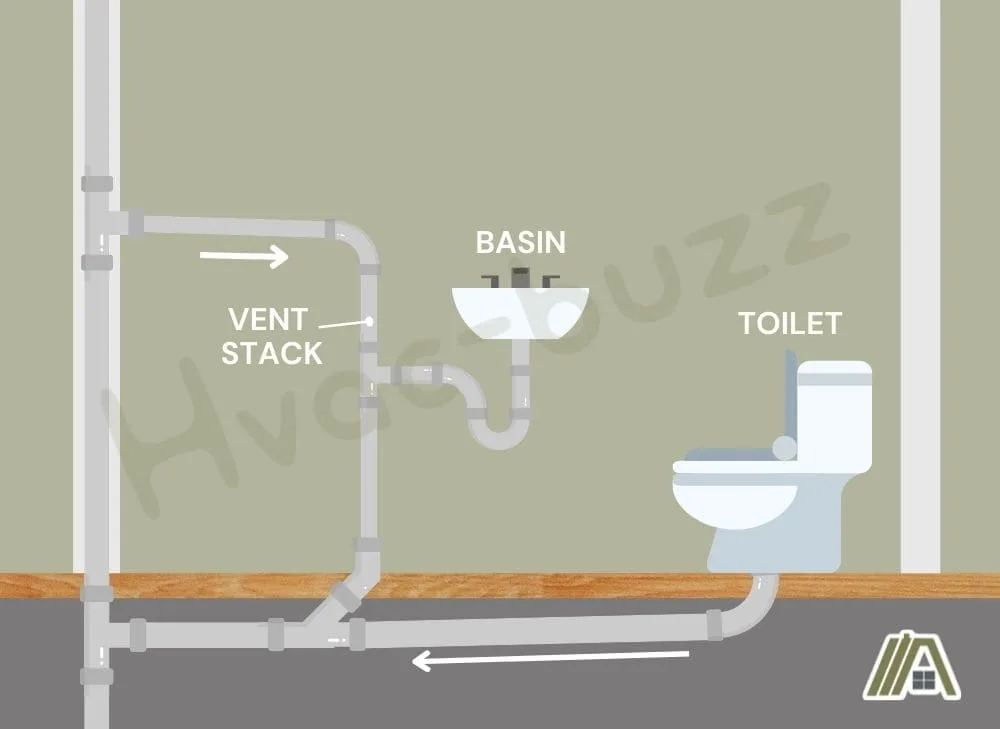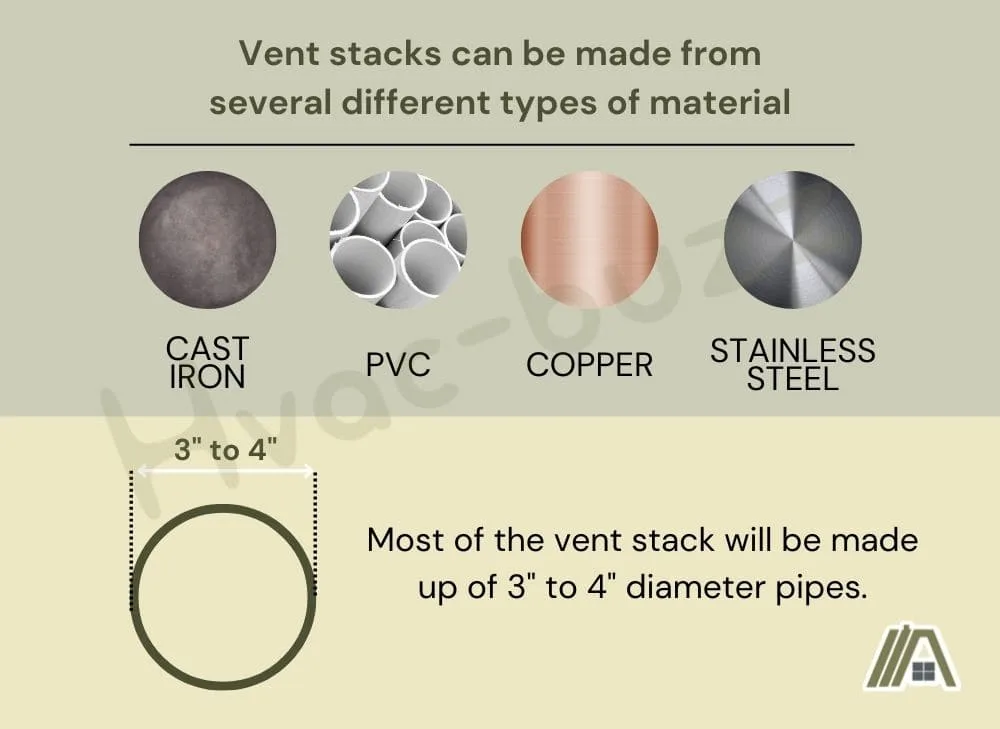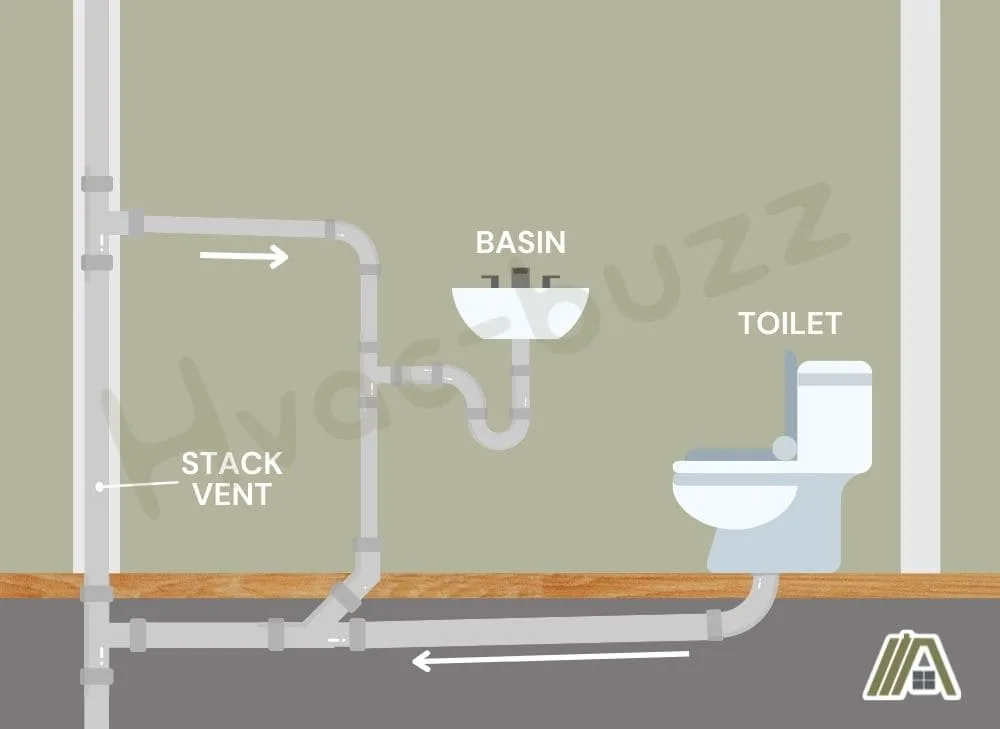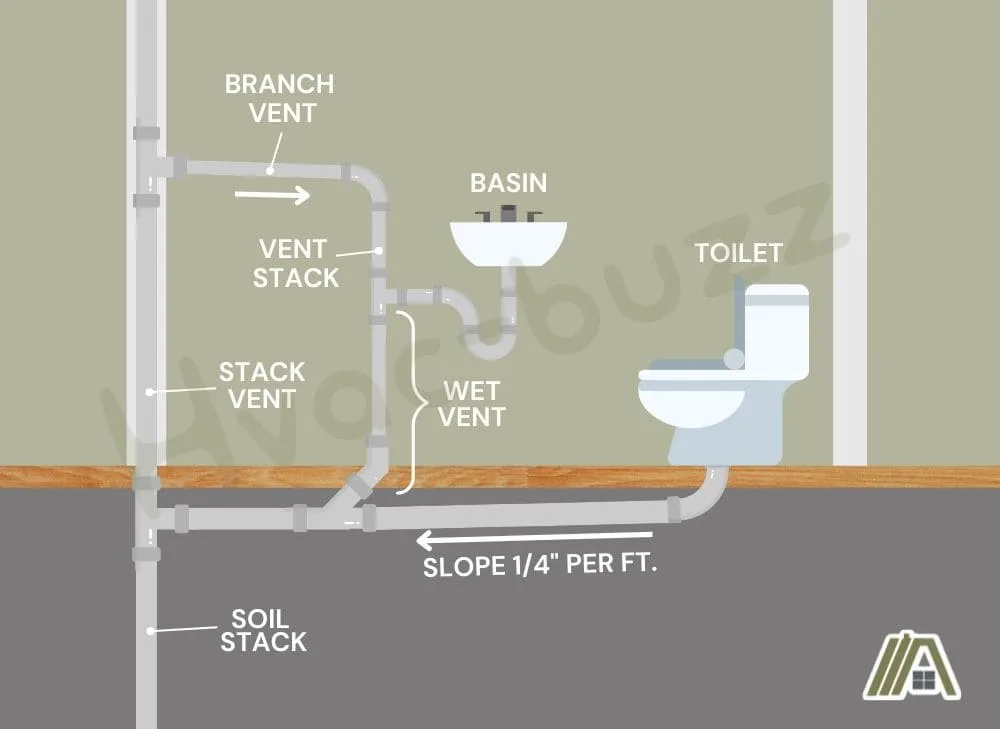
The vent stack and stack vent are part of the same plumbing length. The vent stack is the main, vertical vent for the houses plumbing system. The stack vent is the uppermost portion of the vent stack, which extends to the outside.
Difference Between Vent Stack and Stack Vent: Overview
It’s easy to confuse a stack vent and a vent stack, given their similar names and purposes. After all, both are used for venting plumbing and, in truth, they are two parts of the same whole.
However, a vent stack is technically the name for an entire pipe that serves as the main line of connection for plumbing appliances throughout the home.
On the other hand, a stack vent makes up only the upper portion of this main drainage pipe. It is the end that exits through the roof, allowing air pressure to be maintained throughout the home’s plumbing.
What is a Vent Stack?
A vent stack is a vertical pipe that connects to and is used in a home drainage system. It may also simply be referred to as a “vent pipe.”
What Is It Used For?
Vent stacks are the primary terminal for the collection and removal of both gas and liquid waste from your home’s plumbing system.
They allow all water waste to connect and drain into the sewer line, while the sewer gasses exit through the roof of the home.
Position and Location
There are several different types of plumbing vents. All of them, however, must at some point connect to the main vent stack, or the “true vent.”
This main vent stack attaches to your house’s sewer line at its lower end, and the other end terminates—or exits—through the roof of the building.

However, this terminating end of the vent stack is actually the portion that is considered the stack vent, which we will get into later.
Each home must have at least one vent stack. It must be far enough from any openings like windows to prevent vented gasses from making their way back into the home once they exit the stack vent portion.
Because of this, the vent stack is likely to be somewhat centered in the house, which also makes it easier for other plumbing around the home to connect to it.
It should be noted that you can normally tie only eight fixtures to a single vent stack, although this may vary slightly depending on local codes.
Purpose
As briefly mentioned, a vent stack’s two primary purposes are the streamlined collection and removal of your home’s sewer waste, and the maintenance of proper air pressure.
Because all plumbing fixtures in the home connect to the vent stack, it collects and drains all the water waste from the home at some point. While this waste falls down through the plumbing, any gaseous waste makes its way up out of the pipe.
Because the vent stack connects to the stack vent and feeds out of the roof, the gas within your plumbing is also able to exit the home. Without an exit, pressure would build up within the plumbing and prevent the liquid waste from being able to drain freely.
Materials and Sizes
Vent stacks can be made from several different types of material, but it is most common to see them made from cast iron, PVC, copper, or stainless steel pipe, since these are durable materials that hold up well to corrosion and time.
As for size—generally, most of the vent stack will be made up of 3″ to 4″ diameter pipes. The upper portion of the vent stack is the primary exception, but we will get into that later, since that is the stack vent.

The length of the vent stack can vary greatly, considering homes also vary greatly in height. Including the lower soil stack and upper stack vent portions, a vent stack will typically start 6″ above your roof, and will descend several feet below the ground.
Maintenance Requirements
Typically, a vent stack will not require any major or regular maintenance. As long as it is installed correctly, it should remain blockage-free for quite some time.
This said, you should clean (or have your vent stack cleaned by professionals) as soon as you begin noticing strange smells, slow draining, gurgling, or slow flushing that point you towards an issue with the vent stack.
Most Common Problem
Speaking of issues with the vent stack, the most common problem they can have is a blockage. Buildup within the pipe will prevent it from allowing your home’s plumbing from being able to drain freely.
If this occurs, gas buildup may occur. This could be the cause of any strange smells you notice, particularly near your plumbed appliances, and could cause headaches or nausea.
Since your vent stack is not allowing plumbing waste to drain effectively, this would be the cause of any slow draining you notice when using the sink, tub, or toilet.
What is a Stack Vent?
A stack vent is the last few feet of a home’s main plumbing vent, or vent stack.
It is the portion that starts above the highest horizontal drain connection, runs through the roof, and terminates 6″ above the roof or above the highest anticipated level of snow.
What Is It Used For?
As mentioned, a stack vent is technically part of the vent stack. The vent stack removes water waste from the rest of the home, and the stack vent helps with this process.
Stack vents assist with this because they are the portion of piping that exits the roof, meaning they connect a home’s internal plumbing to the outside of the home.
This allows sewer gasses to be vented out of the plumbing system, preventing pressure buildup from the gas that would keep the liquid waste from draining.
Position and Location
The vent stack runs all the way from the roof of your home to several feet below ground. It is generally a straight pipe, with no or minimal curves to allow for optimal waste removal.

Different parts of the vent stack go by different names, and the uppermost portion of the vent stack is the part that is considered the stack vent.
It can terminate through the roof or through the sidewall.
If terminating on the roof, it must extend at least 6″ above the roof in order to function properly, as this positioning prevents most clogs from external factors like snow, or leaves, and makes access more difficult for animals.
Purpose
As mentioned before, the stack vent serves the exact same purpose as a vent stack—it allows the buildup of sewer gasses within the home to rise and exit through the roof of the home.
When sewer gasses build up, they can cause health problems in the form of nausea, headaches, irritation, fatigue, and even death in severe cases.
Outside of health problems, the build up of sewer gasses within your home’s plumbing can increase the pressure. This pressure increase will prevent the liquid waste from being able to drain effectively, and may cause your plumbing appliances to gurgle and drain slowly.
Materials and Sizes
As an extension of the vent stack, the stack vent is likely to be made out of the same materials. This includes iron, copper, steel, or PVC piping.
However, it may not have the same diameter. Building codes may vary from place to place, but it is most common to see stack vents that are 2″ in diameter.
This is because codes generally require that they are at least half as wide as the soil stack.
The soil stack is the name for the lower portion of the vent stack, which connects to the sewer line, and is normally 3-4″ in diameter.

As for length, the stack vent only runs for a few feet before it widens and is once again considered the vent stack.
Maintenance Requirements
Since the stack vent is technically part of the vent stack, its maintenance requirements are exactly the same. In other words, it doesn’t require any maintenance unless it fails, either because it has cracked or clogged.
If it cracks, it needs repair or replacement, and if it clogs, it simply needs to be cleared.
Most Common Problem
The most common problem with stack vents is clogging. While they are again part of the vent stack, any clogging that is specifically occurring within the stack vent is likely to be caused by debris build-up, like leaf litter. In rare cases, a small animal might have found its way into the pipe.
Regardless, you will likely need help from a professional plumber to clear the clog.
Table of Differences Between Vent Stack and Stack Vent
| Vent Stack | Stack Vent | |
| Used for | Centrally gathers and removes gas from the home’s plumbing | Allows gas waste to exit from the home’s plumbing |
| Where it starts | Several feet into the ground (from the sewer line) | Starts as part of the vent stack, a few feet from the roof |
| Where it terminates | Into the stack vent | Outside |
| Location in plumbing system/house | Somewhat central to allow easy connection for all plumbing appliances | Upper portion of vent stack that exits through the roof, sidewall, or soffit |
| Purpose | Vents the ventral waste drain for all plumbing throughout the home | Vents gaseous waste outside and maintains air pressure within plumbing system |
| Materials | Copper, cast iron, stainless steel, PVC | Copper, cast iron, stainless steel, PVC |
Sources
https://bluefrogplumbing.com/4-signs-its-time-to-clean-out-your-plumbing-exhaust-vents/
https://diy.stackexchange.com/questions/117674/how-many-soil-stacks-should-a-house-have
https://homeguides.sfgate.com/tying-plumbing-vent-stack-68724.html
https://pamperingplumber.com/difference-vent-stacks-stack-vents/
https://sandiegoplumbingandpipelining.com/plumbing-vent-stack/
https://trusteyman.com/blog/how-to-tell-if-your-plumbing-vent-is-clogged/
https://trusteyman.com/blog/whats-a-plumbing-vent-pipe-and-how-does-it-work/
https://www.aboutmechanics.com/what-is-a-soil-stack.htm
https://www.ahs.com/home-matters/repair-maintenance/learn-about-plumbing-vents/
https://www.angi.com/articles/how-do-plumbing-vent-stacks-work.htm
https://www.bhg.com/home-improvement/plumbing/drain-venting/
https://www.biegplumbing.com/waste-stack-repair-replacement/
https://www.nuflowmidwest.com/the-difference-between-building-vent-stacks-and-stack-vents/
